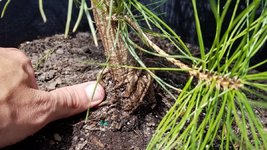AcerAddict
Shohin
For several months, I've been scouring nurseries both local and online for a standard JBP with a decent start in order to make it a part of the Japanese garden I'm planning in our back yard. Finally found one in a 3-gallon pot at Wilson Bros. in Georgia and had it shipped here last week. It was pretty pot bound, so I slipped it into a 15 gallon the day after it arrived where it will stay until I decide what to do with it.
As for the question, is there any potential in this tree as a bonsai, or should I just use it for the original purpose of being part of my garden? It's 42" high (106cm) from the soil line, and has a 1" (2.5cm) trunk at the base. There's nothing particularly interesting about the trunk, so I figured it'll be my landscape tree, but thought I'd ask here first just to be certain. Pics attached.
As for the question, is there any potential in this tree as a bonsai, or should I just use it for the original purpose of being part of my garden? It's 42" high (106cm) from the soil line, and has a 1" (2.5cm) trunk at the base. There's nothing particularly interesting about the trunk, so I figured it'll be my landscape tree, but thought I'd ask here first just to be certain. Pics attached.






